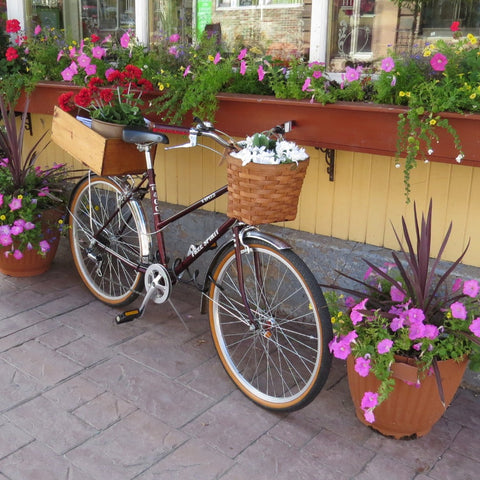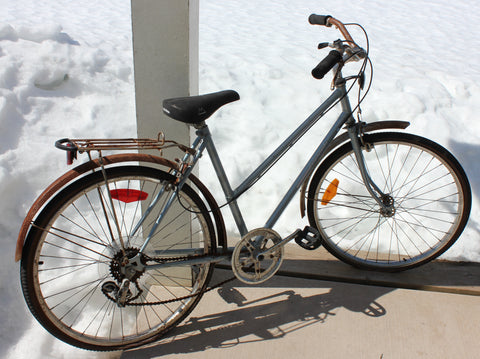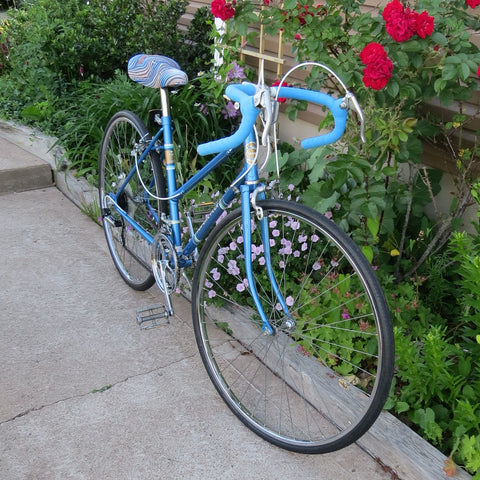
So in an effort to identify some of the sources and post-purchase expectations for buying a vintage bicycle I offer some advice. These are of course generalizations since every seller has his or her own reasons for selling. As well, every bicycle has its own unique story and condition. Overall, my best advice is to be patient, get some help if needed and do some research.
Vintage Bicycle Sources
Yard Sales: These are bikes that are being sold because the owner has inherited it from an estate, their parents or it is their personal bicycle from a time when they rode a lot. The owner simply no longer wants, needs or has space for it. These are usually your best find. These bikes have often been stored indoors and are being sold for a very reasonable price: $20-50. They are sold as-is.

(Retired) Neighbourhood Bicycle Mechanics and Shops that Sell used Bicycles: These are often retired gentleman who have some/extensive experience working on bicycles either on their own or as a former mechanic. They enjoy the work and sell bicycles to supplement their income. They often have a variety of styles, makes, etc., including vintage models. Their bicycles have been tuned-up to varying degrees and are usually sold at reasonable prices ($100-200). They are a relatively good value. Bicycle shops that sell used bikes will also fall under this category.
Bicycle Restorationists: These are businesses that specialize in taking an old bicycle and making it new again. They often work on and sell better quality bicycles or bicycles of a particular vintage/maker. The main difference is that these bicycles have been stripped down and every part inspected, cleaned (replaced if needed) and the bicycle is rebuilt. In many cases, this includes refinishing, or polishing and waxing the original paint. Some deal in only high end bicycles. These bicycles are the most expensive to purchase but also work like new and look great. In many ways, it is similar to buying a new bicycle, but with character.
Road Ready
What the potential buyer needs to acknowledge at the outset, is that buying a vintage bicycle from a yard sale or picker, will require that the bicycle be tuned up and have worn out parts replaced. Often the cost of having the work done by a bicycle shop will exceed the purchase price up to several times the original cost. This off course depends on what you expect from your new ride. If “ridable and safe” is what you desire, then tires, tubes, cables (if present) and a tune-up may be just enough to get you going. Expect to spend between $100-150 minimum. That is assuming there are no major issues and this does not imply that the bicycle will work at its optimum. If the bicycle has parts that no longer work and need to be replaced your vintage bicycle dreams may come to an abrupt end (see below). The converse is also true. You may have found a real gem that will cost you nothing but some air in the tires to get you rolling. The later is quite rare, however.
Be aware that parts for many vintage bicycles are not commonly stocked by main stream bicycle shops. For example a pre 1980 bicycle will likely have a non standard 26" (not the same size as the common 26” mountain bike wheel) or a 27” wheel which are no longer the standard wheel sizes. I guarantee you that the majority of local bicycle shops (LBS) do not have one in stock. Nor would they have the tire to fit one. You may be able to convert the bicycle to a newer sized wheel, but then you are talking even bigger money. Coaster hub, three speeds and freewheels are all part of the history of bicycle technology. They require special tools and knowledge that may or may not be available at your LBS. It often depends on the age of the shop and the age of the mechanics that work there. Nonetheless, they do still exist. Or if your bicycle mechanic is willing, there are lots of resources out there, like Sheldon Brown, that they can get the “how to” from.
More often however, the conversation between you and the sales/service staff at the shop you go to will gently drift towards the amount of time and money it will take to “repair” your bicycle and for just an extra $__.00 you could have this shiny new bicycle with the most recent brake and shifter technology. It comes with a warranty and we will give you 20% off accessories at time of purchase. And in all truthfulness that may not be a bad option depending on what you wheel into the shop. Just remember why you wanted a vintage bicycle in the first place…the look, the quality, the environmental considerations, etc. (But if you do decide to buy new, I may buy that “vintage trash” from you just the same.)
 Of course I would encourage you to buy a restored bicycle if vintage is what you’re after. That’s what I do and what I believe offers the greatest value in getting a vintage bicycle. But it is not the only or best choice for everyone. The important thing is to know your options. Then factor in your expectations and your budget. Then go buy the bicycle of your dreams (or at least the best you can afford). In the end, just make sure you get a bicycle and enjoy riding it.
Of course I would encourage you to buy a restored bicycle if vintage is what you’re after. That’s what I do and what I believe offers the greatest value in getting a vintage bicycle. But it is not the only or best choice for everyone. The important thing is to know your options. Then factor in your expectations and your budget. Then go buy the bicycle of your dreams (or at least the best you can afford). In the end, just make sure you get a bicycle and enjoy riding it.
Take care, Daryl

